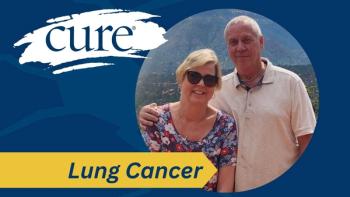
Patients Experienced Fewer Symptoms After Lung Cancer Surgery When Using an Electronic Reporting System

Patients with lung cancer whose symptoms were managed by automated alerts to their care team through an electronic system after surgery had fewer post-surgical complications than patients who received standard care.
Patients with early-stage lung cancer who reported symptoms on an electronic survey after surgery that were managed by their doctors via alerts had a lower symptom burden compared to those who underwent usual care post-surgery, according to recent study results.
Some of the symptoms monitored throughout this study included fatigue, pain, shortness of breath, disturbed sleep and coughing. Bellinda King-Kallimanis, director of patient-focused research at LUNGevity, explained in an interview with CURE® that it is important for patients to report their symptoms, as many side effects and symptoms can be managed while mild if intervened upon early.
“Early detection of symptoms and side effects helps the care team to put in place supportive care and can alert them earlier to possible complications from (for example, surgical complication in this study). In other studies that looked at symptom alerts with systemic treatments, it can also help detect reoccurrence or disease worsening earlier. And this is how proactive monitoring of symptoms via electronic survey can help alert the healthcare team to proactively manage complications and improve survival and quality of life for patients,” she said.
Improving Symptom Management With Patient-Reported Symptoms
Before surgery, patients with early-stage lung cancer were randomized to receive either postoperative symptom management based on their reported outcomes (83 patients; intervention group) or usual care (83 patients). Both groups of patients reported symptoms before surgery, daily after surgery and twice a week after hospital discharge for up to four weeks. Treating surgeons would respond to alerts from patients when symptoms were reported that crosseda concerning threshold. Symptoms included shortness of breath, pain, disturbed sleep, fatigue and coughing.
At discharge, patients in the intervention group reported fewer symptoms compared with those who received usual care. The difference between the groups was also observed at four weeks post-discharge.
Additionally, patients assigned the intervention had a lower post-surgery complication rate compared to those assigned usual care (21.5% versus 40.6%, respectively). Surgeons addressed alerts from the intervention group in a median of three minutes.
King-Kallimanis explained that electronically reporting outcomes may provide patients the opportunity to report more and milder symptoms than the time on a ward round allows for with their treating surgeon. Some patients may also feel more comfortable ticking a box compared to listing all these symptoms and side effects in-person setting as seen with usual care.
“Usual care puts the burden on patients to report anything that might be a little bit milder or uncomfortable to talk about to their physician. When they're in the hospital recovering from surgery — like in this study, the patient probably doesn’t know exactly when their doctor will be coming by, and may forget to mention something, like say shortness of breath, in that couple of minutes visit. And by allowing people to report their symptoms on a tablet, they can take a little bit of time to think about it and don't feel as rushed when they're with their doctor,” she said.
She added that patients who were sent home after surgery with supportive care in place, including the ability to report symptoms online, were able to focus more on recovery. Oftentimes, patients in the outpatient setting don’t know if they should call their care team about a symptom they are having as they worry about inconveniencing their busy doctor.
“Patients may minimize their symptoms and … maybe think there's probably nothing much that can be done, … and for some they don’t want to be a burden or inconvenience.” she said.
That is why using an electronic reporting system can be beneficial for patients, because they may be reporting a symptom or a side effect that if isn’t caught early can lead to something worse down the road, she explained.
“(We) don't want (patients) minimizing side effects. If you're talking about diarrhea (or) constipation, we have supportive care medications that can help. And it is important patients get information on this because if left untreated, that diarrhea could go on to be more severewill take a person off treatment versus catching it earlier and it being managed, and hopefully maintaining the treatment for longer,” King-Kallimanis said.
She added that often, patients may not see the benefit in completing surveys, though she stresses that these can be used to help patients get the best care possible.
“I think patients need to know why there is value in completing these surveys, that there's something in it for them. It really can be used to influence how (they) might get the best treatment for (them), as we saw in this study” she mentioned.
Potential Issues With Real-World Implementation
Of note, patients in this study had a “surprisingly” high compliance rate, King-Kallimanis said. This may have to do with a study coordinator following up with patients to complete their responses; however, that follow-up isn’t always available and is resource intensive.
“In the study, where you have people (like) a nurse practitioner or a study coordinator, who’s able to follow up and make sure you get that (patient-reported) response, you’re able to really have an impact. I think in the real world, where there are clinics and hospitals that don’t have the necessary infrastructure in place, in that there may not be someone available to call all the patients receiving treatment to make sure you get the (patient-reported outcome) completed , especially when they're at home,” she said.
Additionally, patients in this study had a mean age of 52 years, this doesn’t represent the average age of lung cancer patients. The authors didn’t discuss why. In addition, King-Kallimanis mentioned those who sign up for studies such as this one often have higher education and fewer access to care barriers, so she and her team think there needs to be care to ensure that these services also are provided to those in underserved communities.
“There are gaps in our understanding of how to scale these monitoring services up for all cancer patients. We want to make sure that you don't just give those who already have the highest ability to access services more tools to do that better. We don’t want to leave people behind and create an even bigger digital divide,” she concluded.
For more news on cancer updates, research and education, don’t forget to





